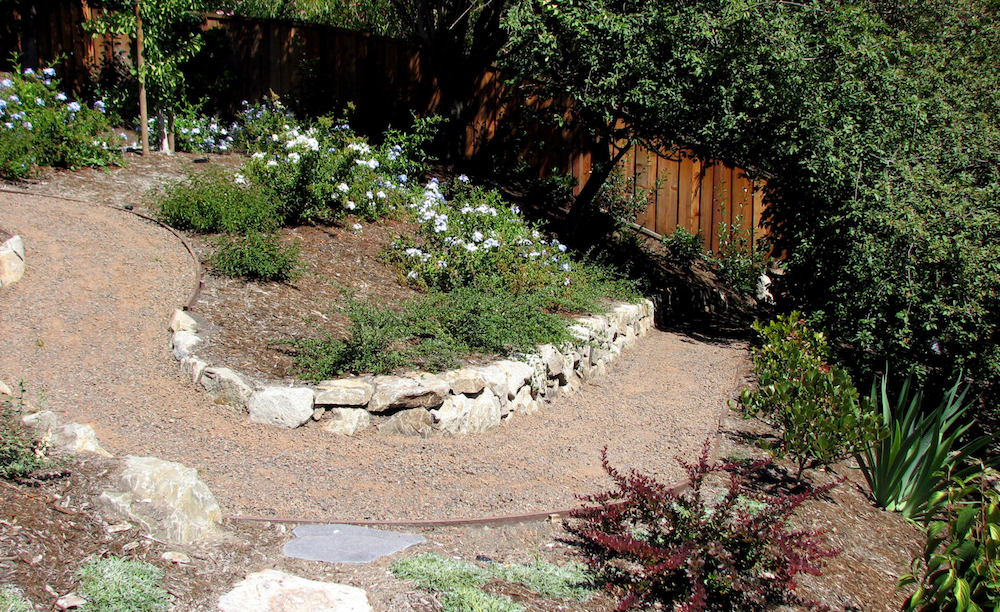Three Ways to Reduce Soil Erosion and Landslide Risk
Soil erosion occurs when loose portions of topsoil are displaced, usually by wind or rain. For the most part, erosion is a natural process, but it can become a problem when weather conditions accelerate the rate of topsoil loss, such as on a cliff or hillside following heavy rains. With so many neighborhoods in the Bay Area built on steep terrain, many homeowners worry about soil erosion and the accompanying landslide risk during the rainy season. Making major investments in retaining walls or foundation reinforcement is one option, but there are less costly measures homeowners can take to help protect their properties as well.

Choosing the right plants and landscape features can help reduce soil erosion on sloped properties. Photo: Dana Lund Landscaping, LLC ©2018
Choose Plants That Slow Erosion
Plants play a central role in preventing soil erosion—a hillside with little or no vegetation will wash away more quickly when there’s nothing holding the soil in place. The best plants for preventing erosion are ones that have deep root systems, because roots bring stability to the soil layers. But identifying plants that can survive the harsh conditions of a California cliff is tricky. These plants need to be drought-resistant (as you won’t be able to water them frequently or provide irrigation), perennial (so they have time to establish deeper root systems year after year) and hearty (as slope-side soil has few nutrients). Some suggested species include sumac, daylily, yellow jessamine and lantana. Since the Bay Area is home to a wide range of soil zones, a professional landscaping service can help determine which plants will be most successful on your property.
With the soil held firmly in place by deep-rooted plants, native species adapted to the thinner topsoil can fill in the gaps. Succulents may seem like a good drought-resistant choice, but these plants have shallow root systems and water-heavy leaves, making them poor tools for erosion control. Possibilities include California poppy, bluebells, flax and many others.
Create Conditions for Tree Growth
Establishing tree growth is also important for reducing soil erosion, especially for sloped terrain that’s more rocky or muddy (and therefore more prone to landslide risk). Trees have deeper root systems and add even more stabilization than smaller plants. During periods of heavy rainfall, their leaves will slow the rate at which rain reaches the ground and their deep root systems can help absorb an excess of water. Trees also trap runoff and sediment, mitigating the level of soil erosion. Varieties that do well on slopes include manzanita, Monterey pine and California live oak.
Rock Out
In addition to selecting appropriate plants for hillsides, homeowners can incorporate rock features into their landscapes to reduce the rate of water absorption during a storm. Riprap stones, which have been industrially crushed, are a good choice for preventing erosion. Generally, jagged rock will do a better job of stabilizing soil than smooth rock. Installing sediment trap rocks can reduce erosion in low areas, such as around storm drains. As water and runoff reach low-lying areas, larger stones can slow the rainwater current and help trap sediment.
Use Diamond Certified Resource to find top rated companies.
Local, Top Rated Diamond Certified Companies Related to Your Topic
Santa Clara County Landscaping Contractors
Sonoma County Landscaping Contractors
Monterey County Landscaping Contractors
Alameda County Landscaping Contractors
Marin County Landscaping Contractors
Related Articles
The Homeowner's Guide to Landscape and Lawncare
Get Expert Advice From Owners of Top Rated Local Companies
Become a Diamond Certified Preferred Member (Always Free)